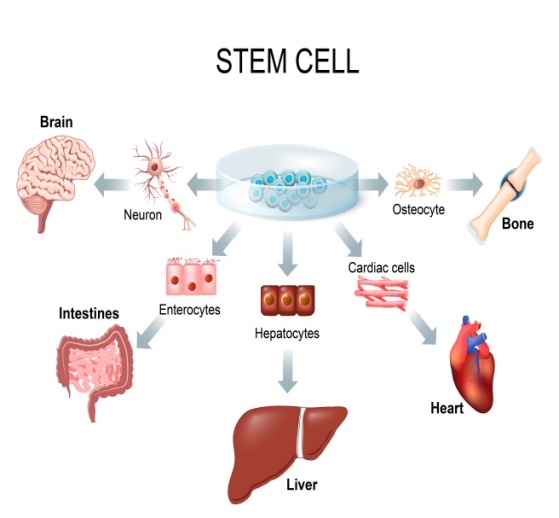Stem Cells

Stem cells are a kind of cells that are less differentiated. Stem cells can be divided by different classifications according to self-renewal (the ability to produce more stem cells), clonality/proliferation (the capacity to proliferate indefinitely), and potency (the production of one or many differentiated lineages). In addition, based on the origin of stem cells, they can be divided into embryonic stem cells, adult/somatic stem cells, cancer stem cells, and induced pluripotent stem cells.
The type of stem cell
Induced pluripotent stem cells (iPSCs) are a type of pluripotent stem cells that can be induced directly from adult somatic cells, which have been reprogrammed artificially and turn on the expression of specific pluripotency genes. This reprogramming can be achieved using a number of techniques with varying efficiencies.
Embryonic stem cells (ES cells or ESCs) are pluripotent stem cells derived from the inner cell mass of blastocyst. ES cells can form tissues from all three primary germ layers (ectoderm, endoderm, and mesoderm) of the embryo. So they are capable of differentiating into all cells of the adult body, as well as some, but not all, extra-embryonic tissues.
According to previous studies, cancer stem cells (CSCs) are very small parts that have important tumor initiation potential in tumor growth. Compared to normal stem cells, the cancer stem cells are believed to have lost the control of cell proliferation.
Adult stem cells are undifferentiated cells that reside among differentiated cells in tissues or organs. They have the ability to renew themselves and differentiate into specialized cell types. Not like embryonic stem cells, adult stem cells are limited to differentiate into distinct cell types of their tissues of origin, and they are therefore multipotent or unipotent stem cells. The primary roles of adult stem cells are to maintain and repair the tissues in which they reside. The most studied are stem cell populations present in bone marrow (hematopoietic stem cells and mesenchymal stem cells), intestine, and skin, but there are distinct populations residing in many other organs, such as in the central nervous system, liver, mammary gland or dental tissues.
Pluripotent stem cells and embryonic stem cells have prospects in the field of regenerative medicine. Because they can propagate indefinitely, and produce all other cell types in the body (such as neurons, heart, pancreatic, and liver cells); they represent a single source of cells that could be used to replace those lost in damage or disease. However, the use of viral vectors (especially retro or lenti viruses that randomly incorporate into the host genome) for iPS colony generation increases the risk of tumor formation. Besides, routinely utilized methods for inner cell mass isolation necessitate destruction of an embryo, leading to ethical concerns. Additionally, there is a risk for tumor formation if ES cells are not fully directed into a differentiated cell type prior to surgical implantation. For therapeutic applications in people, another major concern is the use of non-human materials such as fetal bovine serum and mouse feeder cells to derive ES cells.
Secondly, several pathways above on which cancer stem cells (CSCs) depend have been proved and will represent future therapeutic targets. Clinical trials are under way evaluating agents that target stemness pathways, including Wnt, TGF-β, Notch, Hedgehog, and JAK/STAT pathways, in a wide variety of cancers. Thirdly, adult stem cells have been used in the clinic for de-cades to treat blood diseases. Transplantation of hematopoietic stem cellsis an established therapy, including transplants from bone marrow, peripheral blood, and cord blood. Neural stem cells are also expected to be used for severe spinal cord injury, as they are able to support the functional regeneration of the spinal cord. Besides, MSCs can also be a therapy for type 1 diabetes mellitus (T1DM). Possible applications for MSCs also include the treatment of for heart attack, as well as pulmonary disease.
References:
- Tao Wang, Sarah Shigdar, Michael P. Gantier et al. Cancer stem cell targeted therapy: progress amid controversies.Oncotarget. 2015, 6(42): 44191-44206
- Aleksandra Filipovic, Justin Stebbing, Georgios Giamas. Cancer stem cells—therapeutic targeting or therapy. The lancet. 2013, 14:579-580
- Jaffer A.Ajani, Shumei Song, Howard S.Hochster et al. Cancer Stem Cells: The Promise and the Potential. Seminars in Oncology.2015,42(2):3-17
- Jayesh Sagar, Boussad Chaib, Kevin Sales et al. Role of stem cells in cancer therapy and cancer stem cells: a review. Cancer Cell International. 2007, 7(9):1-11
- Catherine H. Hackett, Lisa A. Fortier. Embryonic Stem Cells and iPS Cells: Sources and Characteristics. Vet Clin North Am Equine Pract. 2011, 27(2): 233–242.
- Slaven Erceg, Victoria Moreno-Manzano, Marcela Garita-Hernandes et al. Concise Review: Stem Cells for the Treatment of Cerebellar-Related Disorders. Stem Cells. 2011, 29:564–569